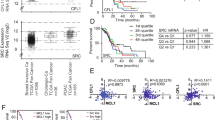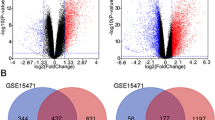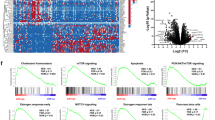Abstract
Pancreatic adenocarcinoma (PDAC) is a highly aggressive cancer with a high chance of recurrence, limited treatment options, and poor prognosis. A recent study has classified pancreatic cancers into four molecular subtypes: (1) squamous, (2) immunogenic, (3) pancreatic progenitor and (4) aberrantly differentiated endocrine exocrine. Among all the subtypes, the squamous subtype has the worst prognosis. This study aims to utilize large scale genomic datasets and computational systems biology to identify potential drugs targeting the squamous subtype of PDAC through combination therapy. Using the transcriptomic data available from the International Cancer Genome Consortium, Cancer Cell Line Encyclopedia and Connectivity Map, we identified 26 small molecules that could target the squamous subtype of PDAC. Among them include inhibitors targeting the SRC proto-oncogene (SRC) and the mitogen-activated protein kinase kinase 1/2 (MEK1/2). Further analyses demonstrated that the SRC inhibitors (dasatinib and PP2) and MEK1/2 inhibitor (pimasertib) synergized gemcitabine sensitivity specifically in the squamous subtype of PDAC cells (SW1990 and BxPC3), but not in the PDAC progenitor cells (AsPC1). Further analysis revealed that the synergistic effects are dependent on SRC or MEK1/2 activities, as overexpression of SRC or MEK1/2 completely abrogated the synergistic effects SRC inhibitors (dasatinib and PP2) and MEK1/2 inhibitor (pimasertib). In contrast, no significant toxicity was observed in the MRC5 human lung fibroblast and ARPE-19 human retinal pigment epithelial cells. Together, our findings suggest that combinations of SRC or MEK inhibitors with gemcitabine possess synergistic effects on the squamous subtype of PDAC cells and warrant further investigation.




Similar content being viewed by others
References
Ferlay J, Soerjomataram I, Dikshit R et al (2015) Cancer incidence and mortality worldwide: sources, methods and major patterns in GLOBOCAN 2012. Int J Cancer 136:E359–386
Siegel RL, Miller KD, Jemal A (2017) Cancer statistics, 2017. CA Cancer J Clin 67:7–30
Hidalgo M (2010) Pancreatic cancer. N Engl J Med 362:1605–1617
Kleeff J, Korc M, Apte M et al (2016) Pancreatic cancer. Nat Rev Dis Primers 2:16022
Binenbaum Y, Na’ara S, Gil Z (2015) Gemcitabine resistance in pancreatic ductal adenocarcinoma. Drug Resist Update 23:55–68
Burris HA 3rd, Moore MJ, Andersen J et al (1997) Improvements in survival and clinical benefit with gemcitabine as first-line therapy for patients with advanced pancreas cancer: a randomized trial. J Clin Oncol 15:2403–2413
Moore MJ, Goldstein D, Hamm J et al (2007) Erlotinib plus gemcitabine compared with gemcitabine alone in patients with advanced pancreatic cancer: a phase III trial of the National Cancer Institute of Canada Clinical Trials Group. J Clin Oncol 25:1960–1966
Conroy T, Desseigne F, Ychou M et al (2011) FOLFIRINOX versus gemcitabine for metastatic pancreatic cancer. N Engl J Med 364:1817–1825
Von Hoff DD, Ervin T, Arena FP et al (2013) Increased survival in pancreatic cancer with nab-paclitaxel plus gemcitabine. N Engl J Med 369:1691–1703
Vennin C, Murphy KJ, Morton JP, Cox TR, Pajic M, Timpson P. (2017) Reshaping the tumor stroma for treatment of pancreatic cancer. Gastroenterology 154:820–838
Bailey P, Chang DK, Nones K et al (2016) Genomic analyses identify molecular subtypes of pancreatic cancer. Nature 531:47–52
Subramanian A, Narayan R, Corsello SM et al (2017) A next generation connectivity map: L1000 platform and the first 1,000,000 profiles. Cell 171:1437–1452 e1417
Di Veroli GY, Fornari C, Wang D et al (2016) Combenefit: an interactive platform for the analysis and visualization of drug combinations. Bioinformatics 32:2866–2868
Chou TC, Talalay P (1984) Quantitative analysis of dose-effect relationships: the combined effects of multiple drugs or enzyme inhibitors. Adv Enzyme Regul 22:27–55
Tiong KH, Tan BS, Choo HL et al (2016) Fibroblast growth factor receptor 4 (FGFR4) and fibroblast growth factor 19 (FGF19) autocrine enhance breast cancer cells survival. Oncotarget 7:57633–57650
Voon YL, Ahmad M, Wong PF et al (2015) Nutlin-3 sensitizes nasopharyngeal carcinoma cells to cisplatin-induced cytotoxicity. Oncol Rep 34:1692–1700
Soo JS, Ng CH, Tan SH et al (2015) Metformin synergizes 5-fluorouracil, epirubicin, and cyclophosphamide (FEC) combination therapy through impairing intracellular ATP production and DNA repair in breast cancer stem cells. Apoptosis 20:1373–1387
Low SY, Tan BS, Choo HL, Tiong KH, Khoo AS, Leong CO (2012) Suppression of BCL-2 synergizes cisplatin sensitivity in nasopharyngeal carcinoma cells. Cancer Lett 314:166–175
Wong SW, Tiong KH, Kong WY et al (2011) Rapamycin synergizes cisplatin sensitivity in basal-like breast cancer cells through up-regulation of p73. Breast Cancer Res Treat 128:301–313
Soo HC, Chung FF, Lim KH et al (2017) Cudraflavone C induces tumor-specific apoptosis in colorectal cancer cells through inhibition of the phosphoinositide 3-kinase (PI3K)-AKT pathway. PLoS ONE 12:e0170551
Chung FF, Tan PF, Raja VJ et al (2017) Jerantinine A induces tumor-specific cell death through modulation of splicing factor 3b subunit 1 (SF3B1). Sci Rep 7:42504
Ong LC, Tan YF, Tan BS, Chung FF, Cheong SK, Leong CO (2017) Single-walled carbon nanotubes (SWCNTs) inhibit heat shock protein 90 (HSP90) signaling in human lung fibroblasts and keratinocytes. Toxicol Appl Pharmacol 329:347–357
Tan BS, Tiong KH, Choo HL et al (2015) Mutant p53-R273H mediates cancer cell survival and anoikis resistance through AKT-dependent suppression of BCL2-modifying factor (BMF). Cell Death Dis 6:e1826
Low SY, Choo HL, Tan BS, Tiong KH, Khoo ASB, Leong CO (2011) Suppression of BCL-2 synergizes cisplatin sensitivity in nasopharyngeal carcinoma cells. 5th International Symposium on Nasopharyngeal carcinoma, Penang, Malaysia
Lamb J (2007) The Connectivity Map: a new tool for biomedical research. Nat Rev Cancer 7:54–60
Lamb J, Crawford ED, Peck D et al (2006) The Connectivity Map: using gene-expression signatures to connect small molecules, genes, and disease. Science 313:1929–1935
Collisson EA, Sadanandam A, Olson P et al (2011) Subtypes of pancreatic ductal adenocarcinoma and their differing responses to therapy. Nat Med 17:500–503
Moffitt RA, Marayati R, Flate EL et al (2015) Virtual microdissection identifies distinct tumor- and stroma-specific subtypes of pancreatic ductal adenocarcinoma. Nat Genet 47:1168–1178
Waddell N, Pajic M, Patch AM et al (2015) Whole genomes redefine the mutational landscape of pancreatic cancer. Nature 518:495–501
Keating GM (2017) Dasatinib: a review in chronic myeloid leukaemia and Ph+ acute lymphoblastic leukaemia. Drugs 77:85–96
Nam JS, Ino Y, Sakamoto M, Hirohashi S (2002) Src family kinase inhibitor PP2 restores the E-cadherin/catenin cell adhesion system in human cancer cells and reduces cancer metastasis. Clin Cancer Res 8:2430–2436
Ma YC, Shi C, Zhang YN et al (2012) The tyrosine kinase c-Src directly mediates growth factor-induced Notch-1 and Furin interaction and Notch-1 activation in pancreatic cancer cells. PLoS ONE 7:e33414
Ito H, Gardner-Thorpe J, Zinner MJ, Ashley SW, Whang EE (2003) Inhibition of tyrosine kinase Src suppresses pancreatic cancer invasiveness. Surgery 134:221–226
Kim LC, Song L, Haura EB (2009) Src kinases as therapeutic targets for cancer. Nat Rev Clin Oncol 6:587–595
Lutz MP, Esser IB, Flossmann-Kast BB et al (1998) Overexpression and activation of the tyrosine kinase Src in human pancreatic carcinoma. Biochem Biophys Res Commun 243:503–508
Trevino JG, Summy JM, Lesslie DP et al (2006) Inhibition of SRC expression and activity inhibits tumor progression and metastasis of human pancreatic adenocarcinoma cells in an orthotopic nude mouse model. Am J Pathol 168:962–972
Shields DJ, Murphy EA, Desgrosellier JS et al (2011) Oncogenic Ras/Src cooperativity in pancreatic neoplasia. Oncogene 30:2123–2134
Thomas RM, Toney K, Fenoglio-Preiser C et al (2007) The RON receptor tyrosine kinase mediates oncogenic phenotypes in pancreatic cancer cells and is increasingly expressed during pancreatic cancer progression. Cancer Res 67:6075–6082
Desgrosellier JS, Barnes LA, Shields DJ et al (2009) An integrin alpha(v)beta(3)-c-Src oncogenic unit promotes anchorage-independence and tumor progression. Nat Med 15:1163–1169
Ricono JM, Huang M, Barnes LA et al (2009) Specific cross-talk between epidermal growth factor receptor and integrin alphavbeta5 promotes carcinoma cell invasion and metastasis. Cancer Res 69:1383–1391
Jaganathan S, Yue P, Turkson J (2010) Enhanced sensitivity of pancreatic cancer cells to concurrent inhibition of aberrant signal transducer and activator of transcription 3 and epidermal growth factor receptor or Src. J Pharmacol Exp Ther 333:373–381
Yezhelyev MV, Koehl G, Guba M et al (2004) Inhibition of SRC tyrosine kinase as treatment for human pancreatic cancer growing orthotopically in nude mice. Clin Cancer Res 10:8028–8036
Nagaraj NS, Smith JJ, Revetta F, Washington MK, Merchant NB (2010) Targeted inhibition of SRC kinase signaling attenuates pancreatic tumorigenesis. Mol Cancer Ther 9:2322–2332
Je DW, O YM, Ji YG, Cho Y, Lee DH (2014) The inhibition of SRC family kinase suppresses pancreatic cancer cell proliferation, migration, and invasion. Pancreas 43:768–776
Bartscht T, Rosien B, Rades D et al (2015) Dasatinib blocks transcriptional and promigratory responses to transforming growth factor-beta in pancreatic adenocarcinoma cells through inhibition of smad signalling: implications for in vivo mode of action. Mol Cancer 14:199
Nobis M, McGhee EJ, Morton JP et al (2013) Intravital FLIM-FRET imaging reveals dasatinib-induced spatial control of src in pancreatic cancer. Cancer Res 73:4674–4686
Morton JP, Karim SA, Graham K et al (2010) Dasatinib inhibits the development of metastases in a mouse model of pancreatic ductal adenocarcinoma. Gastroenterology 139:292–303
Duxbury MS, Ito H, Zinner MJ, Ashley SW, Whang EE (2004) Inhibition of SRC tyrosine kinase impairs inherent and acquired gemcitabine resistance in human pancreatic adenocarcinoma cells. Clin Cancer Res 10:2307–2318
Duong HQ, Yi YW, Kang HJ et al (2014) Combination of dasatinib and gemcitabine reduces the ALDH1A1 expression and the proliferation of gemcitabine-resistant pancreatic cancer MIA PaCa-2 cells. Int J Oncol 44:2132–2138
Chee CE, Krishnamurthi S, Nock CJ et al (2013) Phase II study of dasatinib (BMS-354825) in patients with metastatic adenocarcinoma of the pancreas. Oncologist 18:1091–1092
Evans TRJ, Van Cutsem E, Moore MJ et al (2017) Phase 2 placebo-controlled, double-blind trial of dasatinib added to gemcitabine for patients with locally-advanced pancreatic cancer. Ann Oncol 28:354–361
Vena F, Li Causi E, Rodriguez-Justo M et al (2015) The MEK1/2 inhibitor pimasertib enhances gemcitabine efficacy in pancreatic cancer models by altering ribonucleotide reductase subunit-1 (RRM1). Clin Cancer Res 21:5563–5577
Akinleye A, Furqan M, Mukhi N, Ravella P, Liu D (2013) MEK and the inhibitors: from bench to bedside. J Hematol Oncol 6:27
Yang S, Liu G (2017) Targeting the Ras/Raf/MEK/ERK pathway in hepatocellular carcinoma. Oncol Lett 13:1041–1047
Martinelli E, Troiani T, D’Aiuto E et al (2013) Antitumor activity of pimasertib, a selective MEK 1/2 inhibitor, in combination with PI3K/mTOR inhibitors or with multi-targeted kinase inhibitors in pimasertib-resistant human lung and colorectal cancer cells. Int J Cancer 133:2089–2101
Nagaraj NS, Washington MK, Merchant NB (2011) Combined blockade of Src kinase and epidermal growth factor receptor with gemcitabine overcomes STAT3-mediated resistance of inhibition of pancreatic tumor growth. Clin Cancer Res 17:483–493
Acknowledgements
This work was supported in part by the Malaysia Ministry of Education Fundamental Research Grant Scheme (FRGS/1/2017/SKK08/IMU/03/1 to MCW, FFLC and COL; FRGS/1/2016/SKK08/IMU/01/1 to LWH) and the IMU Research Fund (BP I-01/14(05)2017; JLE, PNG, CYL and YJT).
Author information
Authors and Affiliations
Corresponding author
Ethics declarations
Conflict of interest
The authors report no conflicts of interest pertaining to this study.
Research involving human participants and/or animals
No human participants and/or animals was involved in this study.
Informed consent
No informed consent was required for this study.
Electronic supplementary material
Below is the link to the electronic supplementary material.
Rights and permissions
About this article
Cite this article
Er, J.L., Goh, P.N., Lee, C.Y. et al. Identification of inhibitors synergizing gemcitabine sensitivity in the squamous subtype of pancreatic ductal adenocarcinoma (PDAC). Apoptosis 23, 343–355 (2018). https://doi.org/10.1007/s10495-018-1459-6
Published:
Issue Date:
DOI: https://doi.org/10.1007/s10495-018-1459-6




